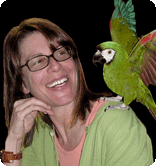The relationship of anting to Sydney’s behavior

Hi Susan, it’s wonderful to see you here! I wrote you about my recently adopted LSC2 who engages in a ceremonious/ritualistic behavior. I am curious if you think this is possibly anting behavior? Here is a short video clip. http://smg.photobucket.com/albums/v232/Echosmom/?action=view¤t=009.flv As always, thank you! Janet

Thanks for your warm hello, Janet! Sending a video link of Sydney’s behavior is a great help. To catch everyone up with our previous correspondence, Sydney is being seen by a veterinarian and you are improving her nutrition and enriching her living environment. This trio is always the right first step.
According to Barrows Animal Behavior Desk Reference, A Dictionary of Animal Behavior, Ecology and Evolution (2nd ed.), anting is a bird’s seizing one or more ants and placing it in its feathers under its wing or elsewhere; crushing the ant with its bill and rubbing its juices on its feathers; dusting itself in an ant hill, or a combination of these activities. Apparently over 200 species of birds do it but I am not aware of any scientific data describing anting with parrots. This would be a good question for you to ask on the main WPT list.
There is a lack of consensus over whether or not similar behavior patterns exhibited with objects rather than ants (wood, eucalypt leaves, paper, novel objects) should be included in the definition of anting. This issue is based on the same reasoning that forms the crux of my response to you: No one really knows why birds engage in anting. Commonly repeated hypothesis include parasite control, food preparation, and sensory reinforcement but it remains, "mysterious and controversial", according to Barrows. So, while the topography (its physical shape and form) is similar to what we see our captive birds do, the extent to which it shares the same function as anting is not knowable at this time.
This is a good opportunity to exercise critical thinking skills. Lots of behaviors have a similar topography that are not functionally the same. For example, the topography of putting on lipstick is the same as putting on lip balm but the function of the former is decoration and the latter is medicinal, relieving dry lips. Sometimes the topographies of 2 behaviors differ but the function is the same. For example, shouting “Hello!” across a crowed room has a very different topography than waving wildly but they share the same function—getting someone's attention.
Regarding the relation between anting and Sydney's behavior, alluring logical hypotheses notwithstanding, more research is needed. Unfortunately, the more urgently we need answers to solve behavior problems, the more likely we are to connect dots invalidly. It takes discipline to hold the line at creative thinking without crossing over the line by generating explanatory fictions.
Another phrase in your email is also relevant to this point. You describe Sydney’s behavior as ceremonial/ritualistic but we can’t know if the behavior serves a similar function as the ritualized behavior of, for example, people with obsessive compulsive disorder (OCD), in spite of its similar topography. The function of the compulsive behaviors in OCD is said to reduce feelings of dread.
Sydney’s behavior is also similar in topography to another behavior pattern called stereotypies, which are characterized by relatively invariant, repetitive behaviors that have no apparent function. Stereotypies are very common among captive animals and people with developmental disabilities. It has been well researched in both the human educational and zoo settings. See http://www3.interscience.wiley.com/cgi-bin/abstract/110573483/ABSTRACT for more info with zoo animals).
Anting? OCD? Stereotypies? Too much time on her beak? Other hypotheses? Our questions exceed our science. Fortunately, if you think Sydney's quality of life would improve by doing this behavior less, the teaching technology of applied behavior analysis can help you teach her to do other behaviors more. Strategies like shaping new behaviors by reinforcing gradual steps toward the goal behavior and differential reinforcement of alternative behaviors are powerful tools to change behavior humanely. I know you are well on your way to accomplishing that goal.
All best,
Susan

































